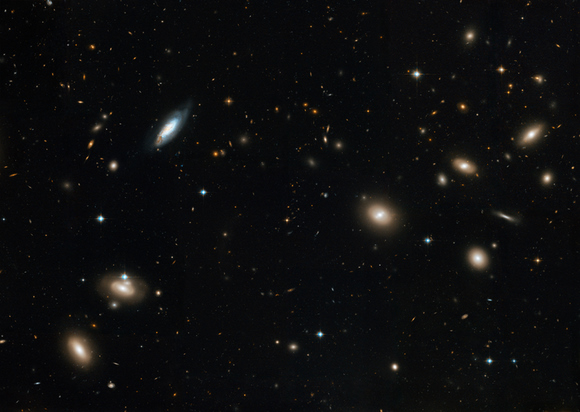The Coma Cluster is one of the densest known clusters of galaxies, containing thousands of elliptical and spherical star systems. The entire cluster is huge, more than 20 million light-years in diameter. It's also very far away, over 300 million light years distant. But no telescope brings the Coma Cluster closer than the Hubble Space Telescope, and a new Hubble image has captured the magnificent starry population in one area of the Coma Cluster with the Advanced Camera for Surveys.
The above Hubble image focuses on an area that is roughly one-third of the way out from the center of the whole cluster. One bright spiral galaxy is visible in the upper left of the image (see below for a close-up of this galaxy). It is distinctly brighter and bluer than the galaxies surrounding it. A series of dusty spiral arms appears reddish brown against the whiter disc of the galaxy, and suggests that this galaxy has been disturbed at some point in the past. The other galaxies in the image are either elliptical galaxies, S0 (s-zero) galaxies or background galaxies that are far beyond the Coma Cluster sphere.
Ellipticals are featureless “fuzz-balls,†pale golden brown in color and contain populations of old stars. Both dwarf and giant ellipticals are found in abundance in the Coma Cluster.
Farther out from the centre of the cluster there are several spiral galaxies. These galaxies contain clouds of cold gas that are giving birth to new stars. Spiral arms and dust lanes “accessorise†these bright bluish-white galaxies, which have a distinctive disc structure.
S0 (S-zero) galaxies form a morphological class of objects between the better known elliptical and spiral galaxies. They consist of older stars and show little evidence of recent star formation, but they do show some structure â€" perhaps a bar or a ring that may eventually give rise to more disc-like features.
This image zooms in on one area of the new Hubble image, the stunning Lenticular galaxy (in the lower left of the first image) with numerous background galaxies visible as well.
The cluster's position in space â€" near the Milky Way's north poleâ€" places it in an area not obscured by dust and gas, making it easily visible from Earth.
Original News Source:
Hubble Site
 Universe Today
Universe Today
